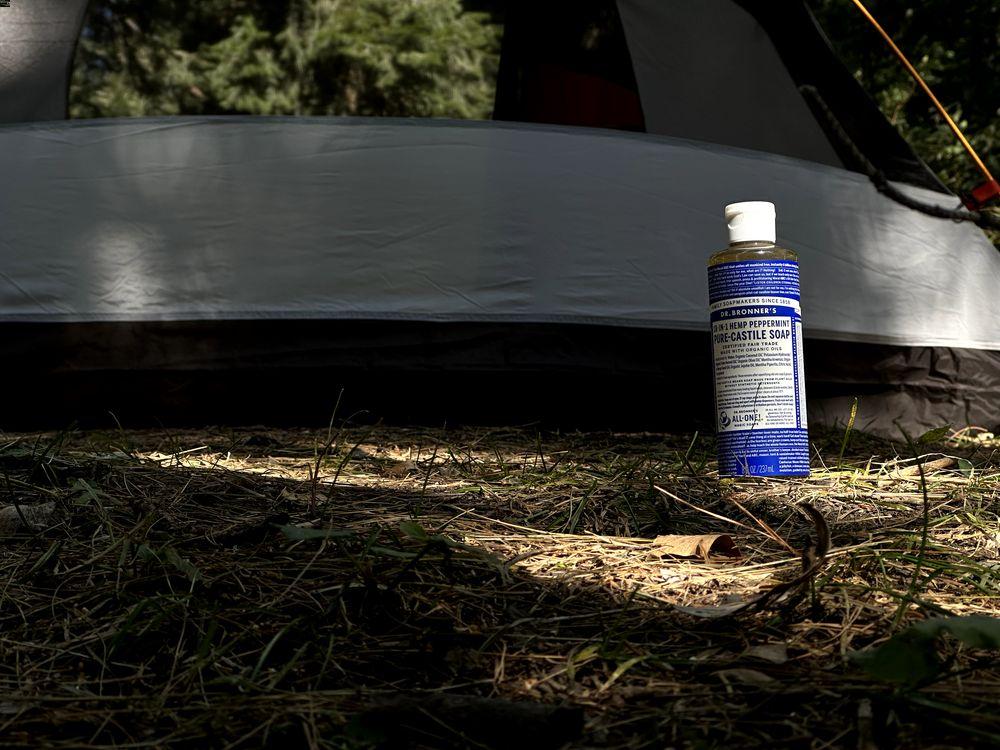We all want a healthy environment and lifestyle, whether at home, outdoors, or anywhere in our outdoor adventure. You know that humans contribute a lot to polluting the environment overall. Research by The National Center for Biotechnology Information shows how soap and its packaging impact Mother Nature, especially during the pandemic when people use soap more frequently.
But how can you contribute to preserving mother nature, not just for yourself but also for the next generations? The answer is by using Biodegradable products. Soap is one of the most commonly used that can be replaced with biodegradable soap.
What is Biodegradable Soap?
Biodegradable soap is made from natural ingredients that decompose or break down easily without creating waste to avoid environmental pollution, unlike ordinary soap, which contains some harmful ingredients and doesn’t dissolve and create pollution. Palm oil, coconut oil, and fruit extracts are expected natural ingredients for making biodegradable soaps.
We use biodegradable soap for cleaning and rinsing. It is prepared to mix in the atmosphere without creating harmful residue. The decomposition of this soap through microbial activity does not create harmful substances in the soil or in the water. Conventional soaps are made of chemical substances that harm the soil and damage ecosystems, while biodegradable soaps add to the health of the environment.
Here are our top picks for the best biodegradable soaps:
Best Overall Biodegradable Soap
1. Dr. Bronner’s Pure Castile Soap
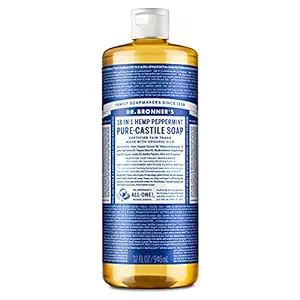
Dr. Bronner’s Castile Soap is the best biodegradable soap made from harmless natural ingredients and is highly popular among backpackers and campers. This is our favorite due to its quality, portability, and packing, which made it easy to carry and use wherever we want on the trail or campsite. In addition to routine cleaning and bathing, you can use this soap as shampoo or toothpaste; there is no need to carry shampoo and toothpaste separately.
During our testing while camping, we found it was efficient to clean our cooking utensils while removing the oil, even if the water was cold. It performed better than other competing soaps which we tested. While using it as shampoo and toothpaste, we did not feel any taste or discomfort as you get it from the regular soap if you have ever tried it as toothpaste.
We also found it friendly and gentle for sensitive skin due to its natural ingredients that don’t cause irritation or skin dryness. In addition, a small bottle of Dr Bronner’s Castile Soap is enough for many outdoor trips as it’s highly concentrated. Put water and a small quantity of Castile soap in a small bowl.
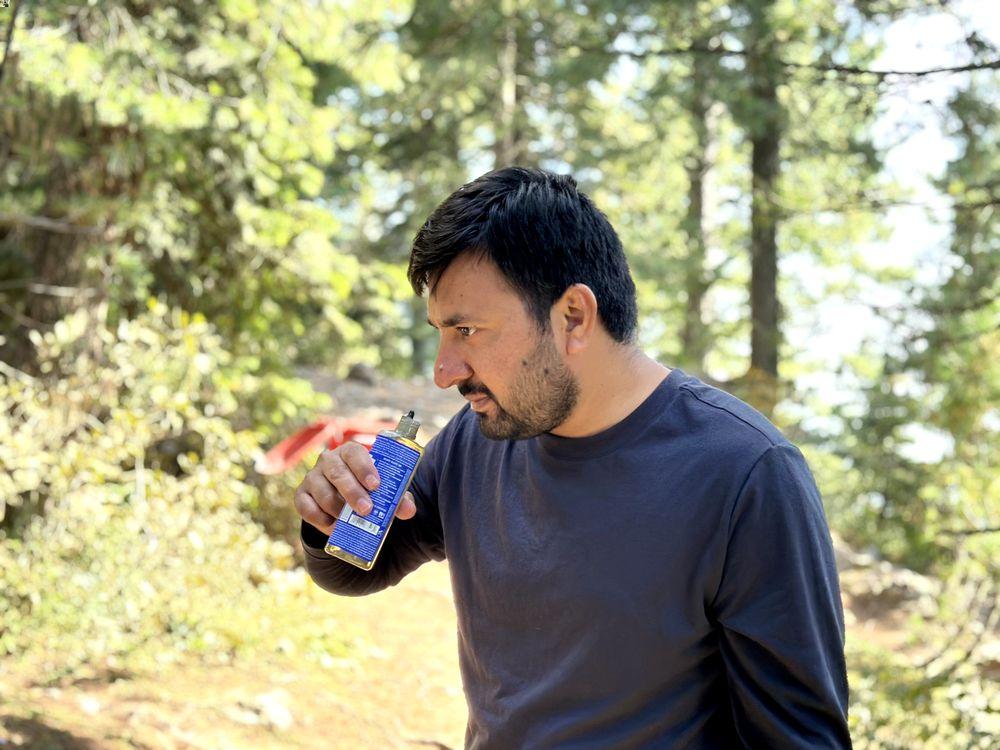
Mix it well; it won’t create much suds like the ordinary soap you use at home, but it does the job well. If you want to take it for backpacking, take a small empty bottle and then fill it with Liquid Soap as it’s too heavy to take a big bottle for backpacking. Try it at home to know how much you use for baths, toothpaste, and other day-to-day activities.
The peppermint scent is pleasant and gives a refreshing feeling after a bath. This multi-use use soap is excellent for hikers, backpackers, and campers alike, with its quality and dense concentration helping serve extended outdoor trips.
Read More: Dr. Bronner’s Castile Soap Review
Best Of The Rest
2. Sea To Summit Wilderness Wash
Sea to Summit Wilderness Wash is a versatile, biodegradable formula used for laundry, hands, baths, dishes, and all-purpose cleaning during camping and backpacking. Like pure castle soap, it’s also a highly concentrated liquid soap, which performs excellently to remove oil and dirt from dishes after pure castle soap.
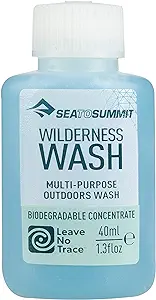
The bottle is pretty tough with a small nozzle and tight lid, so it does leak even if you put it under heavy items in your backpack. It works well for cleaning dishes, body, and gear; you can even use it for shaving and as shampoo like other degradable soaps. The compact bottle is valuable to pack, thus saving useful space in the backpack.
It’s gentle on fabrics and skin but a bit tough on stains. It’s fragrance-free; if you are looking for some fragrance, it’s not for you. You can even take this bottle on the plane as it’s tiny and allowed to be taken.
However, Sea to Summit Wilderness Wash has a few drawbacks. If you have big hair, you might have trouble cleaning it quickly and thoroughly as it does not perform well like regular shampoos. It won’t be enough for more heavy cleaning, like washing gear, etc., and we suggest taking a bigger bottle.
3. Coleman Camp Soap Sheets
If you are an ultralight backpacker and don’t want to carry liquid or bar soap, Coleman Camp Soap Sheets are an excellent option due to their lightweight and compact design. You can fit this in your pocket or a small space in your backpack as they will only take up a little space. These soap sheets are unscented and biodegradable and won’t impact the environment, and you can freely use them on the trail or while camping.
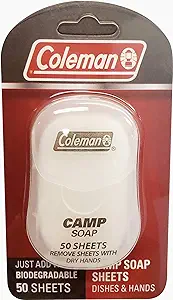
How do I use these sheets? Take some water and dissolve them, and you will get sudsy lather water, unlike Castle soap and See to Summit wilderness wash. Coleman Camp Soap Sheets are a great way to keep your hands clean and refreshed while enjoying the outdoors.
Coleman Camp Soap is perfect if you are on short hikes. However, if you are camping and cooking, we advise you to use Castile Liquid Soap if you need a soap to use more often. Otherwise, you will have to carry a few packets of these sheets, which are less effective than the other two we reviewed. However, these are easy to use; you need water to wet your hands and then rub the soap on your hands. The soap will lather up and clean your hands well. The soap is also very gentle on your skin, so it doesn’t dry out your skin as some other soaps can.
They are very cheap and compact. If you can, we suggest you take them with you even if you carry liquid soap. Another significant benefit of these soap sheets compared to liquid soap is that you can use them much more quickly. With liquid soap, you often dilute it before using it, which can take a significant amount of time.
4. CONCENTRATED CAMPSUDS Soap
AMPSUDS Soap is another solution for campers and travelers due to its lightweight design, environment friendliness, and effectiveness in cleaning yourself and your gear while on the trail.

Unlike Sea to Summit Wilderness Wash, this comes with the peppermint oil fragrance, in case you like to use fragrance-based soap. This soap is made with vegetable-derived ingredients to make it gentle for mother nature and your skin and body. This super-concentrated can wash clothes, bath soap, shampoo, and anything washable.
Additionally, this soap works very fast to clean the body or gears without causing any irritation on the skin. We noticed that it cleans the gears efficiently and quickly, even if dirty. Moreover, this soap is safe for skin, hair, and clothes as it does not harm the skin. We have used it at home and during camping to wash our stuff.
Its performance is also reasonable compared to Dr Bronner’s Pure Castile Liquid Soap. It’s good for backpackers due to its compact design and lightweight.
Biodegradable Soap Alternatives
Biodegradable Wipes are an alternative option to biodegradable soaps.
Wipes are easy to use, and they don’t require water. In addition, you can find wipes made with ingredients that are safe for the environment. Soaps are also an option but require water and can be harsh on the skin. Wipes are a good choice for people with sensitive skin or who don’t want to use soap.
In addition, wipes are easy to store and transport since they are lightweight and compact.
Here are quick recommendations:
Biodegradable Soap Types
Here are the three main types of biodegradable soap
Liquid
Liquid soaps are the most popular type of biodegradable soaps, which are easy to use and widely available from stores to online markets. However, these are a bit expensive compared to other kinds of soap. But these soaps are highly concentrated and can be used long.
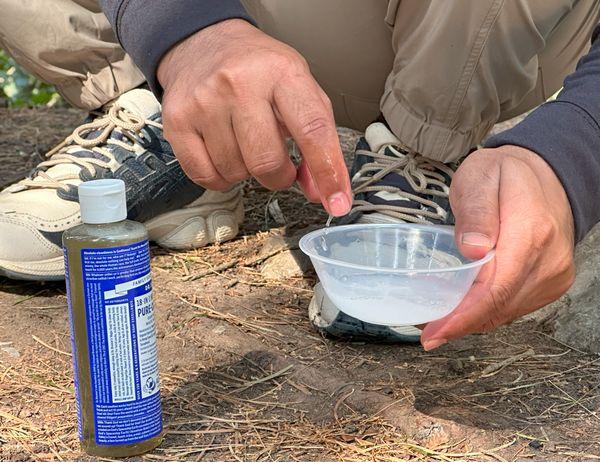
We prefer liquid soaps because they are easier to store after use than soap bars. For example, if bar soap gets wet, it becomes difficult to carry, and you have to be careful as it becomes soft after a few uses.
But liquid, on the other hand, packed in a bottle is a much safer option. They can be used for a variety of purposes during camping. Dr Bronner’s Pure Castile Liquid Soap and CONCENTRATED CAMPSUDS Soap are good options.
Bar Soaps
Bar soap is the second most popular type of biodegradable soap. They are less expensive than liquid soaps; you can easily find them in stores and markets. These are the traditional soap bars that you usually use at home.
Bar soaps are not as easy to use and manage as liquid soaps during hiking or camping. They get wet after use, and you must put them carefully as they become soft. However, bar soap is a more convenient option on the go than liquid soap since it does not require carrying a separate container to dilute it.
Soap wipes/ Power Soap
Powder soap and soap wipes are the least popular type of biodegradable soap. This is because they are more difficult to use than liquid or bar soap. Still, they are the most affordable type of biodegradable soap.
How to Choose Biodegradable Soap: Buying Guide
Choosing and evaluating if the soap is biodegradable is difficult, as many companies might need more clarification on the ingredients used to make the soap.
However, based on our comprehensive research, experience, and discussion with industry experts, we shortlisted the best biodegradable soap using different performance parameters, including its ingredients, packaging, and production method.
Ingredients
There is a huge difference between natural and synthetic ingredients of a biodegradable soap. Natural ingredients are eco-friendly, e.g., olive oil, coconut oil, and other essential oils. These ingredients break down into the soil without harming anything and add to the fertility of the soil.
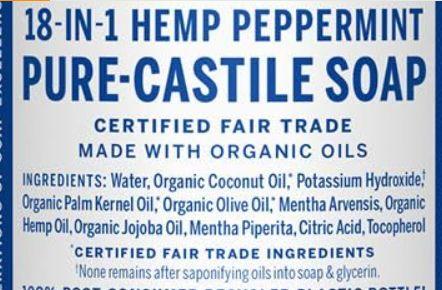
On the other hand, synthetic options like sulfates, phosphates, and parabens create harmful chemicals and pollute the land and aquatic ecosystems. Hence, as per our experience, we recommend natural ingredients that positively impact the environment and ecosystem.
We used several excellent options, including USDA organic and EcoCert-certified, which are purely organic and decompose completely into the soil and create a positive change.
The ingredients might vary from company to company based on the formula. Some use coconut oil, vegetable oil, fruit extract, etc., but they should all be natural.
Packaging
Plastic waste is lethal for all the ecosystems. If you pack biodegradable substances in plastic, the efforts of sustainability will totally go to waste.
Hence, it is important to note that the biodegradable soaps must be packed in cardboard, compostable materials, or recyclable papers to ensure the impactfulness of the efforts.
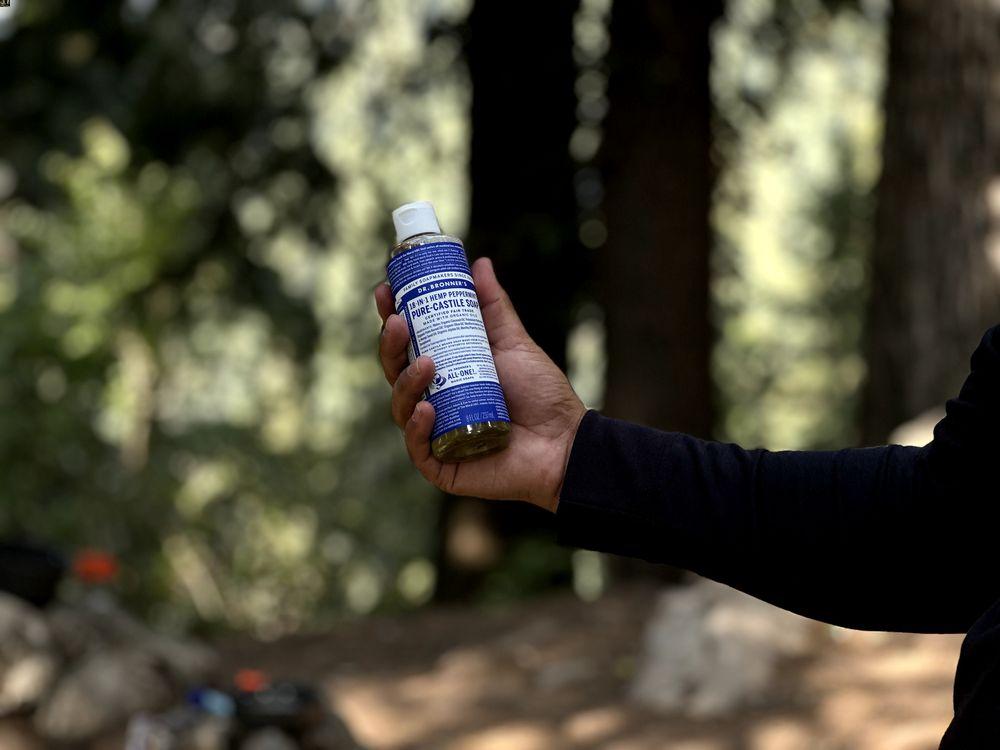
These types of sustainable packaging add to the positive efforts of the biodegradable substances and complement the eco-mission intact.
Many people don’t realize that biodegradable soap packaging can also harm the environment. Most biodegradable soap packaging is made of plastic, which takes hundreds of years to decompose.
Ease of Use
You’ll want to ensure the soap is easy to apply and rinse without leaving any residue. In addition, it’s important to find a soap that will work well with your skin type. Liquid soaps such as Castile Liquid Soap and CAMPSUDS are generally easy to use and store during camping.
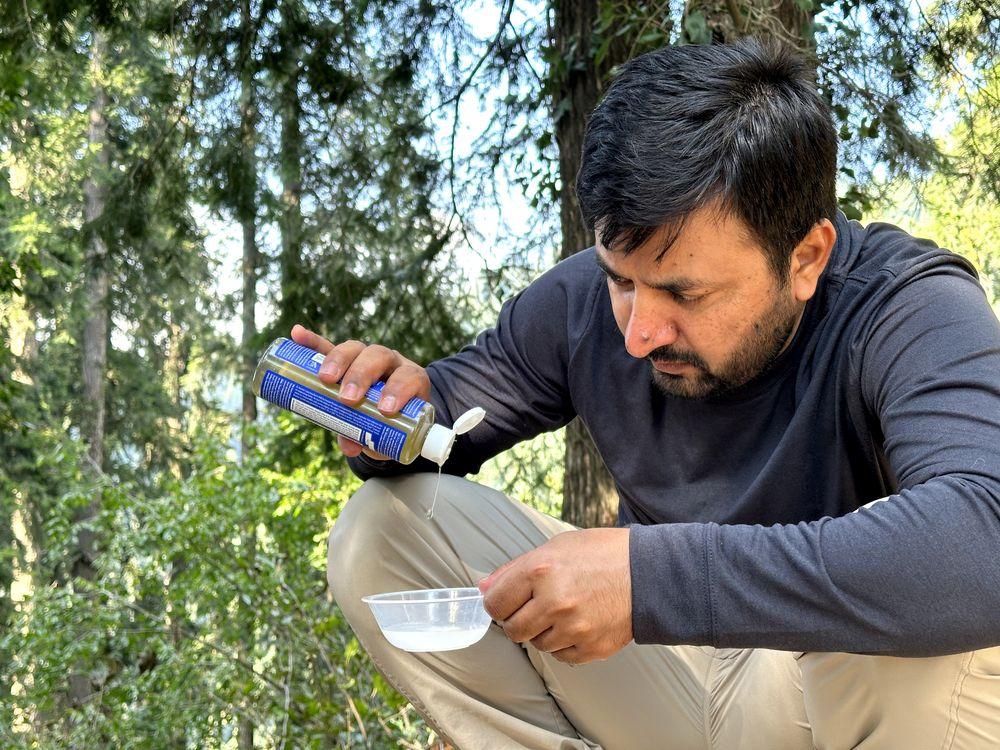
Wipes are good on the go but can be difficult to keep if wet. The same applies to bar soaps. Liquid soap is concentrated and must be diluted before use, while powder soap also needs water to activate it. As a result, soap bars can become wet and difficult to store after use.
Effective soaps and detergents lather in cold and hot water alike. The soaps, which provide better foam by readily dissolving in water, clean the surfaces really well.
Biodegradable soaps have excellent versatility in them as they lather really well with cold water. This property gives them an excellent status among hikers. Adventurers don’t always get warm water for clothes.
As we tested biodegradable soaps, bars like Dr. Bronner’s and liquid alternatives like Campsuds had an astonishing quality of dissolving even in cold water during our hikes. This property allowed us to use little water with exceptional efficiency.
We suggest you use biodegradable bars for portability and soaps for dosing as well as maintaining the eco-friendly environment.
Effectiveness
Biodegradable soaps are highly effective in their action. Their lathering capacity always wins compared to ordinary soaps.
Based on our experience and testing, plant-based soaps provide excellent results compared to the soaps with artificial ingredients. The former creates mild studs with grease and stains but still works excellently.
Additionally, these soaps are derived from essential oils like lavender and citrus, which increase the scents of these soaps, which enhance the experience of the user. We did not use synthetic perfumes with these soaps.
Certification and Brand Reputation
The essence of choosing a biodegradable soap is to find a brand that believes in traits of humanity like compassion, empathy, and non-toxic, eco-friendly practices.
Before buying a biodegradable soap, you must look for certifications like ECOcert and SCS global certification. Additionally, certificates like Fair Trade, Certified B Corporation, and Green Seal make considerable differences in this regard.
If you are looking for further assurances of “no animal testing,” check for certificates like Leaping Bunny or Cruelty-Free certifications.
Size and Portability
Biodegradable soaps are available in different sizes. Compact bars of 3 to 5 oz fit effortlessly in the backpacks. Travel-sized liquids are also available in the portable sizes.
To prevent mess and burden, we suggest you use Matador’s soap bags and Lush’s Naked Bars. These are some of the perfect options for minimalist hikers.
How To Use Biodegradable Soap During Camping?
Most people know that soap is biodegradable, meaning it breaks down into smaller components over time. However, many are unaware that it can still negatively impact the environment—especially when used near water sources.

For example, using soap in a stream or lake can disrupt the delicate balance of the ecosystem and harm aquatic life. It can also pollute waterways, making them unsafe for swimming and fishing.
To minimize environmental impact, it’s best to use soap at least 200 feet away from any water source. This practice helps protect the environment, maintain clean and safe waterways, and supports the principles of Leave No Trace.
How To Make Biodegradable Soap
Making biodegradable soap at home for camping is easy. It requires just a few simple, natural ingredients that are commonly found in kitchens or stores. In addition to the ingredients listed below, you can experiment with different combinations of natural oils. Make sure all oils used are natural, such as coconut oil or palm oil.
To make biodegradable soap, you will need:
- 1 cup of vegetable oil
- 1 cup of lye
- 1 cup of water
- Essential oils (optional)
Instructions:
- In a glass container, mix the vegetable oil and lye
- Stir until the lye is fully dissolved.
- Add the water and continue stirring until the mixture thickens and becomes cloudy.
- Add essential oils, if you want.
- Pour the soap mixture into a mold or container and let it cool for 24 hours.
- Then cut into bars
Conclusion
Biodegradable soaps save the ecosystem from toxic and unnecessary waste. Choosing the best biodegradable soaps can save the water channels and promote ethically credible brands. While choosing biodegradable soaps, ingredients also play a vital role. Synthetic ingredients cause more harm compared to natural ingredients. While choosing the soaps, ensure the plant-based ingredients, opt for eco-friendly packaging, and choose products with credible certifications.
FAQs
What Dish Soap can I use While Camping?
While camping, Dr. Bronner’s Castile Soap is an excellent option if you are a frequent traveler. It is biodegradable and offers excellent packaging with recyclable and reducible options.
Are Soaps 100% Biodegradable?
No product is always 100% biodegradable. Expecting such properties is idealistic. For ease of your choice, we suggest you check for labels like “100% biodegradable” and make sure to avoid soaps with synthetic ingredients.
Is Biodegradable Soap Safe for Rivers?
If you keep biodegradable soaps at a distance of 200+ feet from actual water sources, they are mostly safe for rivers and streams. The ideals of Leave No Trace suggest that even eco-friendly soaps decompose in water and in soil; these soaps eventually take some time to completely detoxify and decompose.
Is Dove Soap Biodegradable?
No, Dove soap is not biodegradable. It contains synthetic ingredients and fragrances, which can add to the soil damage.
